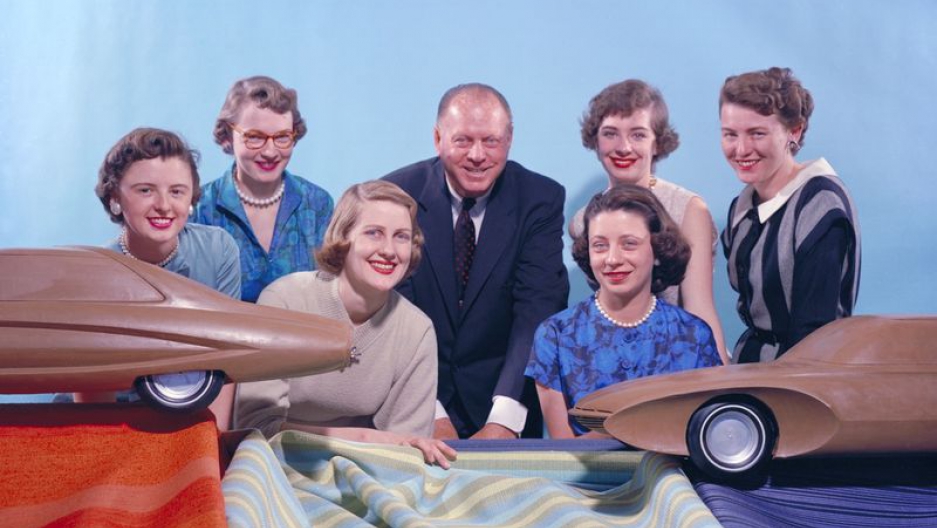
In the past month, two articles of particular interest appeared on my automotive feed. Both were focused on a subject matter rarely covered in the automotive press – the female automotive designer. The first in Autoblog – while featuring multiple photos of Jay Leno – announced the 2020 Automotive Hall of Fame inductees. Included in this year’s class is Helene Rother Ackernecht, believed to be the first woman to work in automotive design. The second article – which appeared in Automobile magazine – noted the unexpected discovery of what is considered the first car designed by a woman, on display at the Petersen Automotive Museum. Perhaps not coincidently, these stories follow the 2018 publication of Constance Smith’s Damsels in Design: Women Pioneers in the Automotive Industry. Although women have been active in the auto industry – albeit in small numbers – for over 75 years, the stories of women who influenced car design have just begun to surface.
Shortly after the release of Smith’s book, I attended a small panel in downtown Detroit that featured Smith, Liz Wetzel – Director of Design at GM Global Design, and Mary Ellen Green, a designer for General Motors during the early 1950s. It was a fascinating, enlightening, and sobering discussion. While Greer spent most of the time describing her duties and projects while working for the notorious Harvey Earle, she also subtlety referred to the daily harassment she faced while working as a female in a male dominated profession. Like most of the women in automotive design, Green was relegated to interior design, sculpting, color and trim, or graphic design.
Helene Rother – featured in Smith’s book as well as the Autoblog article – worked at GM during the same period as Green. A former fashion designer, she fled wartime Europe to take advantage of the “shockingly radical” GM female design team (6). She left General Motors after a few years to work with the famed Italian designer Battista Pinin Farina on groundbreaking post-war vehicles for Nash.
As Wetzel notes in the introduction to Smith’s book, “designing an automobile is extremely challenging and exciting – it is perhaps the most complex consumer product.” She adds, “not many women know about automotive design as a career.” (7). Perhaps it is because, as Wetzel remarks, women like Green left the industry as suddenly as they entered it, for reasons alluded to but not mentioned. There appears to have been a considerable gap before the automotive industry once again welcomed the female designer.
During the early 1980s, Marilena Corvasce was hired by Ghia, the European design studio purchased by Ford in 1970. She was assigned with the task of developing a concept car in the style of the Ford Probe. While Corvasce designed the automobile from start to finish, her name was left out of all the press releases. It was only after the car was selected for display at the Peterson Automotive Museum that she was recognized as the 1982 Ghia Brezza chief designer.
Since Corvasce, only a few women have made their marks as automotive designers. Mimi Vandermolen is responsible for the Ford Probe, Diane Allen for the Nissan 350Z, the first BMW Z4 is credited to Juliane Blasi, and Michelle Christensen was the designer of the second-generation Acura NSX. As Wetzel explains, although the careers of these designers suggest that women have made considerable advances, the number of women in the design studio is still relatively low compared to men.
Perhaps the induction of Rother into the Automotive Hall of Fame spurred this sudden journalistic interest in female automotive designers. Or perhaps it was the publication of Smith’s impressive book that brought newfound attention to women in the automotive industry. Whatever the reason, scholars, journalists, and students of automotive history have embarked upon the important yet painstaking task of recovering the work, lives, and histories of female designers. As Wetzel hopes, perhaps this recognition will not only bring attention to those who have heretofore been lost in the automotive archives, but will inspire young women to consider a future in automotive. As Wetzel writes, “if you are a creative woman who loves solving problems and want to be on the journey to create the greatest advances in mobility of our time, I encourage you to consider a career in the auto industry” (7).
Gustafson, Sven. “Pioneering Designer Helene Rother Ackernect joins Jay Leno among Automotive Hall of Fame Inductees.” Autoblog.com 6 Feb 2020.
Rehbock, Billy. “The 1982 Ghia Brezza is the First Car Designed by a Woman.” Automobilemag.com 27 Feb 2020.
Smith, Constance. Damsels of Design: Women Pioneers in the Automotive Industry 1939-1959. Atglen PA: Schiffer, 2018.
Have you ever considered working in the auto industry? What qualities do you think are important for success in a male-dominated industry? Any and all comments are welcome.